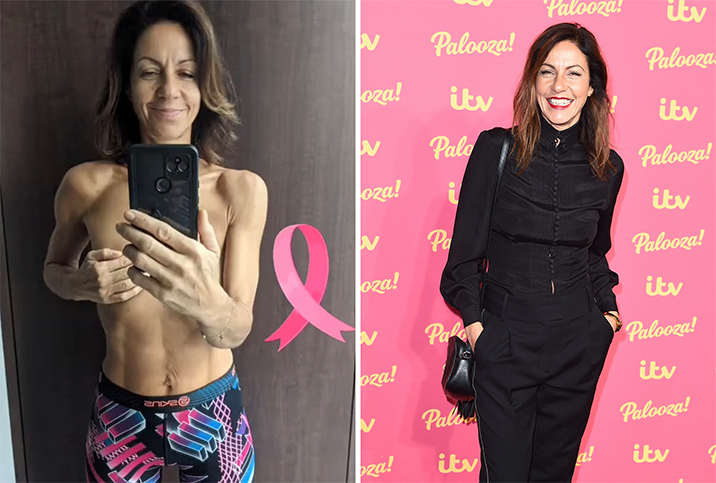Your Guide to Bra Buying Post-Mastectomy

Surviving breast cancer is an impressive feat—something to be celebrated. And while there is plenty of information available for women diagnosed with breast cancer, the path forward after beating cancer is a little murkier.
The American Cancer Society estimates 1 in 8 women will be diagnosed with breast cancer in their lifetime, and surgical interventions, including lumpectomy or mastectomy, are often involved in the treatment plan.
Your diagnosis and treatment will be full of emotional and physical adjustments. One of the considerations to keep in mind after surgery is finding a comfortable and supportive bra that is designed for you.
Each patient's needs are unique, depending on the type of procedure they undergo. Maybe you're joining the 40 percent of women who follow up their mastectomy with reconstructive surgery or perhaps you're opting to "go flat" instead.
Regardless of your situation, here are a few factors to keep in mind when bra shopping for your new body.
Wear a supportive bra immediately following surgery
Whether you have had a lumpectomy or mastectomy, a specialized bra can help in your recovery.
During the final stages of your surgery, your doctor will place surgical drains that remove excess fluid. These drains are temporary, and are generally removed after one to two weeks, but a specialized bra is needed to accommodate them in the meantime. BBC host Julia Bradbury, who recently underwent an emergency mastectomy, showed off her drains and tailored bra in an Instagram post.
Once the drains are removed and you're still healing, you may want something to cover your chest, such as extra padding, because the tender skin surrounding your incisions can get irritated by your shirt rubbing your chest as you move. During this time, your doctor may recommend avoiding structured bras and underwires, as these can cause pain.
Whether you have had a lumpectomy or mastectomy, a specialized bra can help in your recovery.
"It's important that we don't rush our healing process," explained Tibby Reas Hinderlie of Breast Cancer Action. "Most side effects of mastectomy are similar to other surgeries: tenderness, discomfort and possible swelling around the surgical site, temporary limitation of movement of the arm and chest muscles, and sometimes numbness." These side effects can be intensified with the wrong bra or clothing choices.
At around six weeks, most women are fully healed from surgery and can return to their regular clothing, but the bras you choose will depend on whether you opted for reconstruction or going flat.
Factors to consider after reconstruction
"Anyone who has gone through a reconstructive surgery is attempting to appear like they have breasts…but you get what you get with reconstruction, and these mounds of flesh do not act as breasts," said Dana Donofree, breast cancer survivor and founder/CEO of AnaOno, a bra company that specializes in postsurgery undergarments.
Because the flesh that replaces your natural breasts does not have the same density or consistency as it did before, finding the right bra can make all the difference.
Donofree explained that "the underwire in bras can actually cause a lot of pain because underwire is not functionally designed for women with breast reconstruction."
Additionally, Donofree said during breast surgery, nerves within and surrounding the breast are often removed, which compromises the sensitivity of the reconstructed breasts. An ill-fitting bra with an underwire can actually damage the skin and surrounding tissue.
Using breast prostheses or bra inserts
Many women choose not to have breast reconstruction following their mastectomy, but still want the appearance of breasts when they're out in public. A prosthesis, or breast form, creates that look by filling out your bra the way breasts would.
Breast forms are often custom-designed and adhere to the chest. They can be made from a variety of materials, including silicone, foam or fiberfill, which gives them a similar weight and appearance as natural breasts.
For women who prefer a more lightweight and affordable option, bra inserts can be used with specially designed bras that have interior pockets in the cups to hold them.
In addition to a full breast prosthetic, there are also nipple prosthetics for women who have undergone reconstructive surgery but elected to not undergo nipple reconstruction. Nipple prosthetics are adhered directly to the skin of reconstructed breasts.
Insurance may cover your needs
While many women know their mastectomy and reconstructive surgery are covered by insurance, they don't know their prosthetics and bras may also be covered. Medicare, in particular, covers some external breast prostheses and postsurgical bras.
"Many women also don't realize that this coverage is for life," Donofree said.
You will need a prescription from your doctor to cover these items, so talk with them about your needs and check with your insurance provider to find out what is included in your plan.
Final tips and advice
It's important to take your time to find the right style and fit, and this can mean shopping around, but it's worth it to find what makes you feel the most comfortable and confident.
Your chest, regardless of your surgery and reconstructive choices, will be a different size than before. Your reconstructed breasts will lay differently on your chest. Or, if you opted out of reconstructive surgery, finding a bra without cups may be difficult with your current go-to bra company.
Instead of settling for something that's comfortable but not flattering, look for a bra specially designed for breast cancer patients. This will ensure you can get a customized bra that fits your new form.
Breast cancer can completely turn a person's life on end, but feeling whole again after breast cancer surgery is possible. Regardless of your reconstruction options, you can feel like you again.


















